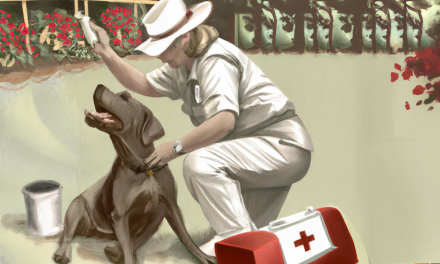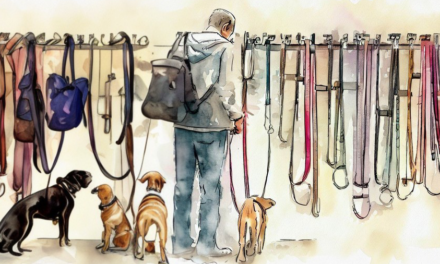Becoming a professional dog sitter can be an incredibly rewarding and fulfilling career path, particularly if you have a passion for animals and their well-being. As a dog sitter, you have the opportunity to care for and spend time with a variety of dogs while also providing the owners with peace of mind that their beloved pets are in good hands.
In the UK, there are no specific qualifications required to become a dog sitter. However, having some qualifications or experience related to animal care can be advantageous in building trust with clients and ensuring that you’re well-equipped to handle any situation that may arise while caring for their pets. It’s important to familiarise yourself with the needs and behaviours of dogs in order to provide the best possible care.
Setting up your dog sitting business requires diligence in marketing your services to attract clients, establishing clear policies and guidelines, and adhering to any local regulations that may apply. Additionally, it’s essential to prioritise the safety and comfort of both the dogs and their owners by obtaining insurance and creating a welcoming environment for the pets in your care.
Understanding the Role of a Dog Sitter
Roles and Responsibilities
As a dog sitter, your primary responsibility is to care for dogs in their owner’s absence. This may involve looking after them when their owner is at work or away on holiday. Some of your key duties include feeding the dogs, taking them for walks, administering any required medication, and ensuring their general safety, happiness, and health. You may work independently or for a pet-sitting company or veterinary clinic.
Skills Required
Being a successful dog sitter requires more than just a love for animals. You should have a solid understanding of dog behaviour and be able to adapt your approach depending on the needs and temperament of each dog in your care. It is beneficial to have qualifications and training in areas such as pet first aid, dog behaviour, or animal care, as these will improve your professional reputation and help you stand out from the competition. Other essential skills include:
- Patience and empathy toward animals
- Good communication skills to interact with dog owners and address their concerns
- Time management and organisational skills for scheduling appointments and managing multiple clients
- Flexibility and adaptability to different situations and environments
Challenges Faced
Being a dog sitter can be rewarding, but it also comes with its fair share of challenges. Some of the common issues you may face include:
- Dealing with problem behaviours: Dogs differ in temperament and behaviour, and some may exhibit aggression, anxiety, or destructive habits. It’s essential to stay calm and address these situations with patience and an understanding of dog psychology.
- Unexpected emergencies: In case a dog becomes sick or injured, you must be prepared to handle the situation and take appropriate action, such as administering first aid or contacting a veterinarian.
- Juggling clients and schedules: As a dog sitter, you’ll need to manage your time effectively and accommodate the various needs and schedules of multiple clients.
By being aware of these challenges and continuously developing your skillset, you’ll be well-prepared to navigate the world of dog sitting and provide excellent care for the dogs in your charge.
Becoming a Qualified Dog Sitter
Required Education and Training
To become a qualified dog sitter, it’s essential to have a good understanding of dog behaviour, care, and basic training techniques. While formal education is not always mandatory, it’s beneficial to take relevant courses on pet care, animal behaviour, or veterinary studies. Additionally, completing a pet sitting and dog walking course can provide valuable knowledge and guidance for your dog sitting career.
Gaining Experience
Experience plays a crucial role in becoming a successful dog sitter. To gain experience, consider volunteering at animal shelters, veterinary clinics, or pet boarding facilities. This will help you develop skills in handling various dog breeds, ages, and temperaments. Another great way to gain experience is by offering your dog sitting services to friends, family, or neighbours. As you build your reputation, you can gradually increase your client base.
Certifications and Licenses
Having certifications and licenses can increase your credibility as a dog sitter, making it easier for you to attract and retain clients. Although obtaining a certification is not a legal requirement in the UK, completing a course such as the NarpsUK Pet Sitting and Dog Walking Business Course can enhance your knowledge and skills. Furthermore, obtaining a disclosure and barring service (DBS) check demonstrates to clients that you are a trustworthy and responsible individual to care for their pets. Consider getting dog sitting insurance, as it provides important peace of mind for both you and your customers.
Setting Up Your Dog Sitting Business
Planning Your Business
To set up a successful dog sitting business, it’s essential to create a well-thought-out business plan. Begin by determining the types of services you will offer, such as basic care, dog walking, training, or grooming. Decide if you will be providing services at your home, the client’s home, or both. Research your local market to understand the demand for dog sitting and any challenges you may face. Additionally, establish your marketing strategy, which may include creating a website, distributing flyers, or using social media to reach potential clients. See here for more information on setting up your (dogs) business in the UK.
Legal Considerations
Before starting a dog sitting business in the UK, it is crucial to be aware of the Animal Activities Licensing Regulations which were established in October 2018. You must contact your local council’s licensing team to obtain the necessary licenses and permits. It’s also essential to obtain proper insurance coverage to protect your business and clients in case of accidents or damages. Lastly, establish clear terms and conditions for your services and draft a contract to ensure both parties understand their responsibilities and expectations.
Setting Prices
To determine the appropriate pricing for your dog sitting services, conduct research on other dog sitting businesses in your area. Consider the variety of services you offer and any additional costs, such as transportation, grooming products, or training equipment. Keep in mind that offering competitive prices will make you more appealing to potential clients, but it’s essential not to undervalue your services. You may choose to charge per day, per hour, or per service. Additionally, offering discounts for long-term bookings or referrals can encourage repeat business and attract new clients.
Marketing Your Services
Building a Website
Creating a professional website is one of the top priorities when starting your dog sitting business. Your website should showcase your services, rates, and testimonials from previous clients. A well-designed website helps build credibility and makes it easier for potential clients to find and contact you. Ensure your site is easy to navigate, mobile-responsive, and includes a clear call-to-action for booking your services.
Social Media Promotion
Social media platforms like Facebook and Instagram can help you reach a wider audience and engage with potential clients. Create a business page on Facebook to share information about your services, post photos of dogs you’ve cared for, and share tips for dog owners. On Instagram, use relevant hashtags and post engaging photos of your dog sitting adventures. Regularly interacting with your followers and responding to comments will help build trust and maintain a loyal customer base.
Client Interaction
Excellent client communication is crucial to building and maintaining a successful dog sitting business. Be responsive to inquiries and always provide clear and accurate information about your services. Build strong relationships with clients by being personable, professional, and demonstrating genuine care for their pets. Also, consider offering a referral programme, where existing customers can receive incentives by referring new clients to your business. This can help expand your client base and solidify a positive reputation for your dog sitting services.
Maintaining Professional Standards
As a dog sitter, it’s essential to consistently uphold professional standards in all aspects of your job. This section outlines various ways to ensure you maintain and improve your expertise and services.
Continued Learning
Seek out opportunities to expand your knowledge and skills in various areas related to pet care. Enrolling in courses, attending workshops, joining industry specific groups can all contribute to your professional growth. Stay updated on the latest pet care news and guidelines which will help you provide higher quality services to your clients.
Health and Safety Protocols
Adhering to health and safety protocols is crucial to ensure the well-being of both you and the dogs under your care. Familiarise yourself with pet first aid procedures and always have a first aid kit on hand. Follow dog day care licensing guidelines provided by local authorities for proper handling, managing risks and maintaining a safe environment.
Some safety measures to consider:
- Regular sanitisation of your equipment and facilities
- Strict supervision during playtime or walks
- Vaccination and health check requirements for the pets in your care
Building Client Relationships
Establishing and maintaining strong relationships with your clients is key to growing your dog sitting business. Keep communication lines open, providing updates on their pets and addressing any concerns they may have. Be reliable and punctual, honouring all commitments and maintaining a professional demeanour. When necessary, ask for feedback and work on areas that may need improvement. A positive reputation will help you gain more clients through word-of-mouth referrals.
By focusing on continued learning, health and safety protocols, and building client relationships, you can ensure your dog sitting services maintain the professional standards that pet owners look for.
Frequently Asked Questions
What qualifications are needed for dog sitting?
While formal qualifications are not required for dog sitting, it’s important to have relevant experience in handling and caring for dogs. Some pet sitters opt to complete courses in pet first aid, dog behaviour, or animal care to enhance their knowledge and credentials. Demonstrating a genuine love for animals and gaining experience in pet care through volunteering or working with a professional pet sitter will enhance your reputation as a reliable dog sitter.
Do I need a licence to become a dog sitter?
In the UK, if you are offering dog boarding or day care services in your home, you may need a licence under the Animal Welfare (Licensing of Activities Involving Animals) (England) Regulations 2018. This licensing requirement varies depending on your location and local council, so it’s best to check with them directly. If you’re just offering dog walking or occasional pet sitting, a licence is usually not required.
How can I find pet sitting jobs near me?
One way to find pet sitting jobs near you is by advertising your services locally, both online and through physical notices. You can also network with professionals in the pet industry, such as vets, groomers, and pet stores, as this can lead to referrals. Additionally, there are various websites and apps that connect pet owners with pet sitters, which you can sign up for to find potential clients.
Is pet sitting a profitable career?
Pet sitting can be a profitable career, depending on factors like location, demand, and the number of pets you can care for simultaneously. Many pet sitters charge between £10 and £20 per hour for their services, so the income potential can add up if you build a solid client base and provide excellent care.
How can I ensure the safety of the dogs I’m sitting?
Ensuring the safety of the dogs in your care is a top priority. You should acquire a solid understanding of dog behaviour and body language, as well as a strong knowledge of first aid for pets to handle emergencies. Additionally, make sure the environment is secure and hazard-free, and always maintain control of the animals while walking or transporting them.
Do I need insurance for a pet sitting business?
Yes, it’s a good idea to have insurance for your pet sitting business. In the UK, there are several insurance providers who offer policies tailored to pet sitters. Insurance can cover public liability, accidental damage or injury to pets, and loss of keys, among other risks. Having insurance not only protects you and your business but also serves as a sign of professionalism and reliability to your clients.








